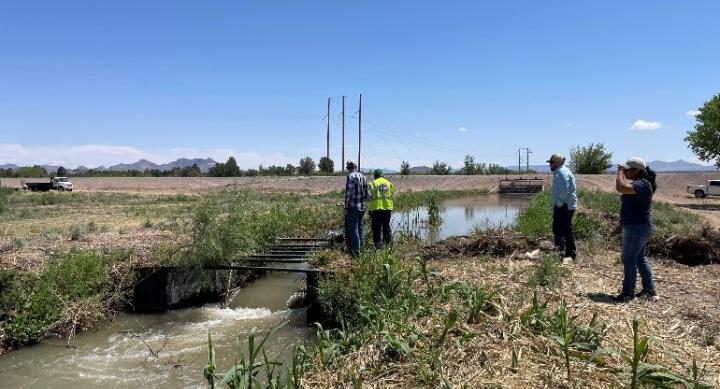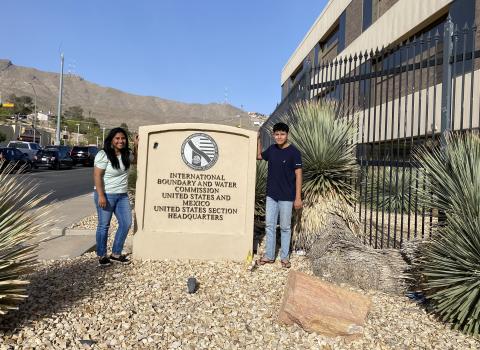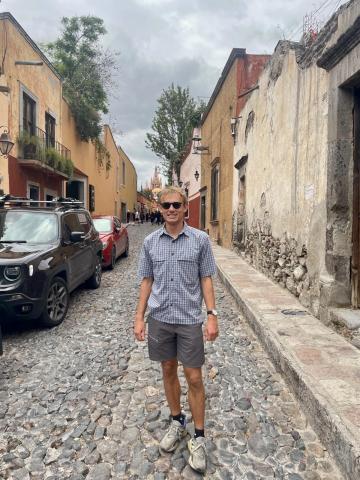
This summer, the RGK Center awarded fellowships to several graduate students through the RGK Global Fellowships program. The fellowships were awarded to students who choose to pursue an international internship placement with an NGO or nonprofit outside of the United States. The blog posts below were written by three of these student fellows who traveled to Mexico this summer.
Marlene G. Plua, MPAff/MCRP Candidate
United States and Mexico International Boundary and Water Commission (USIBWC) - New Mexico, Texas, and Mexico
The Rio Grande/Río Bravo River is one of the longest rivers in North America. It begins in Colorado, flowing over 3,000 kilometers to the Gulf of Mexico. It provides fresh water for seven U.S. and Mexican states. It is the most precious natural resource that sustains life in the border region.
However, the river is overshadowed by geopolitical border discourse dominated by a massive wall that obstructs the river’s majestic beauty to 4-foot-wide water buoys that make the river hostile and unwelcoming. The river is reduced into a single viewpoint- a militarized physical boundary. Unfortunately, the river is in crisis. Water levels are declining due to prolonged droughts, increasing population demand, complex shared water rights, and aging infrastructure.
This summer, I had the opportunity to intern with the Public Affairs Team at the United States and Mexico International Boundary and Water Commission—U.S. Section (USIBWC). This federal agency is responsible for promoting binational cooperation on water management, flood control, and environmental protection along the border, as well as managing the water treaties between the United States and Mexico.
As the Public Affairs intern, I gained hands-on experience in public communication, including monitoring news outlets and social media, editing newsletters, and creating informational materials about IBWC projects. I developed an understanding of the river's threats and its implications to the environment and the people who depend on it, how to respond to crisis situations, and learned to effectively translate complex information into more accessible and engaging content.

The internship also involved public engagement and outreach. I traveled to the Leasburg Extension Lateral Wasteway #8 (LELWW8) site in Las Cruces, New Mexico, where I met with USIBWC maintenance and operational staff. There, I learned about the Commission's sustainable efforts to mitigate flooding, enhance water deliveries, and protect endangered species. The LELWW8 site is one of five restoration habitats for which the USIBWC has acquired water rights. These rights allow the Commission to install irrigation infrastructure and provide irrigated water to sustain the habitat sites.
I also attended a regional meeting in Nogales, Sonora, Mexico, where federal, state, and local officials from the U.S. and Mexico gathered to discuss wastewater and stormwater infrastructure projects and needs in the region. During the meeting, Mexican officials presented a binational water quality study that addressed the discharge of heavy metals from Mexican industries and offered policy recommendations for holding these industries accountable.
My final trip took me to my hometown, Mercedes, TX, where I attended the Lower Rio Grande Valley Citizens Forum. This quarterly public engagement meeting allows USIBWC staff to share information about the Commission's activities with the community and vice versa. Commissioner Dr. Maria-Elena Giner and Hydrologist Delbert Humberston discussed the impact of drought on U.S. rivers and tributaries, emphasizing the importance of building regional resilience with reduced reliance on Mexico's water.
I am deeply grateful to Dr. David Eaton, Dr. Miguel Pavon, and the RGK Center for Philanthropy and Community Service for supporting academic opportunities related to binational water management in the border region. I also want to thank Frank Fisher and Leslie Grijalva from the USIBWC Public Affairs Team for offering me a fantastic experience. Additionally, I want to give a shout-out to the USIBWC staff, who work tirelessly every day to preserve and protect the Rio Grande/ Río Bravo River.
Sam Stone, MPAff Candidate
Universidad Nacional Autónoma de México (UNAM) - Mexico City, Mexico

I worked in Mexico City this summer as part of a binational water conservation and diplomacy project involving the Rio Grande River. The project has two collaborative research teams, the LBJ school at UT, and the Institute of Engineering at the Universidad Nacional Autónoma de México (UNAM). My role was to support the UNAM team's Rio Grande water research initiatives, teach a hydrological modeling program, and foster collaboration between our institutions. I also traveled around a bit to build relationships with other agencies and universities throughout central Mexico.
I greatly improved my Spanish, learned a ton about binational environmental policy, and networked with professionals in a field I aspire to work in. I also escaped the Texas heat for three months, watched a ballet in el Palacio de Bellas Artes, hiked Iztaccihuatl (the 3 highest mountain in Mexico at 17,159 ft), ate many delicious street tacos, and admired Mexico's history at the world-class Anthropology Museum.
I found Mexico to be home to some profoundly soulful people. The directors Alfonso Cuarón and Alejandro Iñárritu come to mind; their movies involving Mexican culture are beautiful conveyances of unique perspectives and human experiences. I took inspiration from the deep observation and intellectual engagement required to produce works like theirs and began writing an article about the importance of bottled water in Mexico. This led me to the work of Ivan Illich, a priest based in Cuernavaca who wrote Las Aguas Del Olvido. He explores water problems in the context of humanity's spiritual relationship with water, arguing that by commodifying it we forsake its sacred, life-giving essence - an insight that resonates deeply with the water conservation challenges we face today.
Brandon Mulder, MPAff Candidate
State of Nuevo León and MexiCO2 - Nuevo León, Mexico
I arrived in Monterrey, Mexico on a sweltering May day after a seven hour drive from Austin. After a brief walk to the train station, and then to the state of Nuevo León’s towering administrative building, I arrived to the first day of my internship with rusty Spanish and dripping with sweat. The next eight weeks would go on to become the most challenging and rewarding experience of my graduate school career.
The state of Nuevo León, the industrial hub of Mexico, has ambitious climate policy goals. The state recently published its Programa Estatal de Cambio Climático, a package of state-level climate adaptation and mitigation policies. A key component within this policy package is the state’s emissions reduction goals – to reduce between 20.8% and 33% (11.2 - 17.7 million tons CO2e) of emissions by 2030, and between 73.1% and 83% (47.1 - 53.5 million tons CO2e) by 2050. The primary way the state intends to achieve that goal is via a carbon tax, similar to those enacted in seven other Mexican states to-date.
The state’s Secretaría de Medio Ambiente was tasked with designing this carbon tax policy, and my role within the secretary’s office was to produce recommendations for how the policy could be designed. On day one, I was at a loss for how to begin. I felt overmatched by the task, especially in a foreign language I was still coming to grips with. So I turned to my LBJ professors for guidance, who put me in touch with experts across the globe with experience designing subnational carbon tax policies. After several informational interviews, I had a policy design template in-hand. I then collaborated with the Mexican carbon non-governmental organization MexiCO2 to design a bespoke carbon tax policy for Nuevo León.
All the while, I took every opportunity I could to explore Mexico – a trip to Mexico City, weekend excursions to pueblos and towns around Nuevo León. My Spanish slowly improved, and the ease with which I could navigate Mexican culture grew therewith. I gained a fuller understanding of what makes Northern Mexican culture distinct, and grew to appreciate the cultural similarities and differences that Texas shares with its neighboring Mexican states. The international border that dividers the two has powerfully divided the two neighbors for close to two centuries, but cultural and familial bonds still bind the two closely together.
Ultimately, I produced a 30 page report to the state’s environmental secretary. My report uses marginal abatement cost curves – introduced to me via my LBJ classes – to propose a carbon tax level of $35/ton CO2e. It suggests flexibility mechanisms to account for companies that would be overburdened by the tax in order to keep Nuevo León economically competitive among its Northern Mexico peers. And it identifies additional data that needs to be collected before Mexican policymakers can understand the impacts of such a tax.
The overall experience had unquantifiable impact on my career. Upon returning to the US, I’ve found a position where I will be able to continue working in the carbon policy space across North American and Latin America. My new role is completely indebted to my experience in Mexico and the financial support from RGK and other sources that made it possible.

